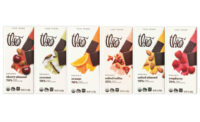
By Bernard Pacyniak
It took Alex Whitmore more than a year after Taza Chocolate produced and sold out its first batch of stone-ground, Mexican style chocolates to realize that he wouldn’t have to produce a smooth-style chocolate to remain in business.
Whitmore, a self-described chocolate lover, had started Taza Chocolate as an offshoot of his original concept, a chocolate café, back in March 2006. As often is the case with such entrepreneurial startups, Whitmore went to his family and friends for financing and support.
In doing so, he wasn’t sure that the world would appreciate a coarser, less refined chocolate that relies on using Mexican stone mills, called molinos, to break down nibs and produce a grainer, more flavorful chocolate. Unlike traditional cocoa processing techniques that use conching to shear the beans to minute particles, often between 16 to 18 microns, this approach “yields a finished product with personality and intense chocolate flavor” Taza’s promotional material says.
Whitmore’s gamble was simple: If we make it, will they buy it?
Thus, after enlisting his friend, Larry Slotnick, and wife, Kathleen Fulton, to fine-tune the concept, source the beans and research the basics of marketing and selling chocolate, Whitmore determined to make a go of it. He found a building in Somerville, Mass., that would lease out 1,700 sq. ft. of space. Upon consulting with Slotnick, who had been in on the ground floor of the formation of another entrepreneurial venture – Zipcar, the unconventional car sharing business that grew into a multimillion dollar corporation – Whitmore signed a three-year lease.

As Slotnick relates, the trip proved successful. Not only did he secure 10 sacks of beans, but the concept of Taza firmly took hold. No longer was it just a mere business plan, one that Slotnick says Whitmore already had impressed him initially; the idea was beginning to have legs. Now, it at least had the cocoa beans.
But it wasn’t until that September, when Whitmore asked Slotnick to help scout out the space, and then join him in making a go of Taza, that he realized this chocolate concept had taken hold.
“Larry practically lived in the space,” Whitmore says. “We were in the process of acquiring machinery, going and doing a few farmers’ markets, learning the business.” And although Whitmore knew what kind of chocolate he wanted to make – he had spent time in Mexico observing the stone-ground milling process – neither he nor Slotnick had any connections to the chocolate industry or the retail community.
“We were building a process, a brand, a product,” he says.
As most newcomers to the confectionery industry discover, the community tends to be welcoming, helping in any way possible.
Although Slotnick and Whitmore’s trip to the farmer’s markets were initially exploratory – “We didn’t even have our own product to sell.” – they were making contacts, collecting e-mails, preparing the groundwork for their forthcoming debut.
On Valentine’s Day, 2007, Taza Chocolate held an open house at its Somerville location.
“We introduced our first chocolate bar, which had 75% cocoa content,” Whitmore says. “We were still wrapping chocolate bars – the wrappers were supplied to us by our friends from the letterpress company in our building – as people were coming in.”
All 1,500 bars sold out.

Employees feed the nibs into the stone mills, which feed the liquor to a mixing tank where sugar is added.
Whitmore would handle production; Slotnick sales and Fulton everything involving branding and creative.
“We only had one employee working in the factory that first summer and fall, Kellie Silsby, who was hired to wrap the product,” Whitmore says.
Slowly, however, business began to build. That summer, Taza introduced the first chocolate disk flavored with cinnamon, the traditional manner of serving up chocolate in Oaxaca, Mexico.
The exotic new product immediately became a hit for Taza. As Whitmore explains, “It’s proved to be a popular item and has driven a lot of our growth.”
It also convinced him that the world, or at least some consumers in it, enjoyed consuming more flavorful, coarser chocolate.
Late that fall, Whitmore hired Mike Schechter, a high school friend and veteran professional skydiver to oversee manufacturing.
“He was looking for a change and I know he was the kind of guy who can make things work very well; he had a can-do attitude,” he says
With Schechter onboard overseeing production, Whitmore could pay more attention to further evolving the Taza concept. And evolve it he did, to the point where sales began to outpace production, prompting the company to make its first expansion in 2010.
“Our three-year lease was coming to an end, and we needed to decide whether to move or find additional space within the building,” Whitmore says.
Fortunately a tenant who occupied 6,500 sq. ft. on the first floor, agreed to move into a smaller space creating for Taza a total first floor occupancy of 11,000 sq. ft. Construction of a new production area began in March 2010 and was completed three months later. With the added space, came increased tank capacity, improved process flow, segregated hot and cold working areas, more storage and additional office space. Thanks to plenty of “D-I-Y” from the Taza team, the investment – including equipment – stayed south of $300,000. Not only did capacity jump, from 400-lb. batches to 3,000-lb. batches, but efficiencies improved. Some things, however, remained sacred.
“When I went to Oaxaca in 2005 to research chocolate, it was fascinating to learn about the origins of chocolate, about the pre-European milling techniques,” says Whitmore, who majored in anthropology. “The beauty and simplicity of the process is what hooked me.”
That, coupled with the direct sourcing of cocoa beans as well as strict attention to bean quality provides the foundation for Taza’sraison d’etre.
“We’re now Direct Trade certified by QCS, Quality Certificate Service, an independent third party, so that consumers and customers can be assured that when we say, Direct Trade, we mean it,” he continues.
In Taza’s case, Direct Trade encompasses three key criteria: Premium payouts for cocoa beans; an annual visit to farmers growing the beans, and adherence to strict quality standards. “Consequently, we’re paying $500 or more over the premium for cocoa beans as posted in the New York market, “ Whitmore says. “Typically, organic beans pay $200 over the premium, and Fair Trade $150.

Kellie Silsby deposits chocolate onto moulds that are headed to the cold room where they are vibrated and then set on racks for them to set.
Not only are beans inspected at origin, they’re also checked upon arrival and prior to roasting, Schechter adds. Typically, cacao beans from the Dominican Republic are shipped to New Jersey. From there, about 60 sacks at a time are transported from the warehouse to the plant in Somerville.
Upon inspection, the beans are loaded into the roasting room area for use. A vintage 1950’s Barth roaster is fired up twice a week for a full day of roasting.
“We do what we call a ‘light roast,’ which entails roasting a 200-lb. batch of beans for 45 minutes at 236 -240° F,” he explains. This allows us to keep a lot of the delicate flavors that are developed in the bean during the fermentation process. The beans are then conveyed to the adjoining Carle & Montanari winnower, also a vintage model.
The cocoa nibs are stored in 150-200-lb. yellow tubs ready for the next stage, which is milling.
There are three milling stations, Schechter points out. To make liquor, the nibs are ground and fed into a mixing tank, which typically holds about 1,500 lbs. The liquor will be mixed with sugar for about 1.5 hours. When making flavored chocolates using vanilla, almonds or cinnamon, the inclusions are mixed in directly with the nibs during milling.
From mixing, the chocolate mass is pumped into a second set of molinos. To make the bar-shaped chocolates, Taza pumps the chocolate liquor to the stone roller milling station, where it undergoes three grinding sequences. The first pressing takes between 20 and 30 minutes, followed by a second and third pass, which takes between two to three hours.
“During each pass the stones come closer and closer together, providing a finer grind to the liquor,” says Schechter. “When we’re doing our 3-oz. bars, the mass is pumped toward stone roll refiners, which were originally used for producing marzipan.”
The bars, he points out, require a finer grind.
Once the chocolate is ready, be it for bars or disks, it’s pumped into a holding tank and ready for tempering and depositing. Once tempered, an operator hand-deposits the chocolate into moulds, which are conveyed into a cold room. The moulds received a slight vibration to settle the chocolate and are then placed on racks to set.
After setting and demoulding, trays are brought into the packaging room where they are hand-packed. At this point, one shift per five-day weeks handles all production. Schechter expects that to increase during the coming fall, with a partial or full second shift coming into play.
Currently, Taza’s products have four main distribution channels: Wholesale; factory store/internet; distributors and foodservice/industrial. The wholesale channel, which encompasses natural food supermarket chains such as Whole Foods and specialty stores, comprises 60% of the sales, with the remaining channels evenly accounting for the remainder.
“From the very beginning, we focused on the natural products section, where our 100% organic, stone-ground products best fit,” Slotnick says. “But during the last three years, we’ve seen the merging of the gourmet and natural food channels. As a result, this allows us to hit both channels.”
Interestingly, Taza’s coarser chocolate has gained favor with pastry chefs seeking to offer customers something different from the typical fine-blended chocolates found almost everywhere.
“We’ve been selling to chocolatiers who are looking for something different,” says Whitmore. “Our chocolate isn’t a couverture.”
He cites Craigie on Main in Cambridge, Mass., which offers a Taza Mexican Chocolate Tart, as well as Jody Adams from Rialto in Cambridge, who uses Taza chocolate in her dessert recipes, as examples.
Of course, Taza’s founders recognize that the bulk of their revenues come from bar and disk sales. Consequently, the trio is committed to “adding products to our catalogue.” This February, the company will add three new flavored disks to its complement: 70% cocoa content in orange, ginger and chipotle chili flavors. In addition, it also will introduce chocolate-covered hazelnuts to round out its line of panned almonds and cashews.

Taza's new factory store serves as the starting point of the company's daily tours.
Part of that evolution continues to revolve around sourcing. As Whitmore points out, one of his goals last year was to develop additional cocoa bean sources. After visiting Bolivia last year, Whitmore contracted for cocoa beans from farmers in a remote area of the country.
“The beans are quite different,” he says. “We’re not exactly sure what the final profile will be like until we start roasting them here in greater volume.”
If all goes according to plan, there should be another new bar later this month.
The ongoing expansion of new products bodes well for Taza, which looks to extend its distribution nationally. As Slotnick points out, sales have continuously grown since its debut several years ago. Excluding the first couple of years, where percentage growth was exponential, Taza has posted extraordinary gains.
“We doubled our sales in 2009 and last year, we experienced a 50% sales growth,” he says. “I see plenty of opportunities.”
Those opportunities exist with current and new customers, Slotnick adds. For example, the company presently sells direct to Whole Foods, having first established itself on the East Coast, then the West Coast and now into the Midwest.
“There are many upper-level supermarket chains where are products would fit,” he says. “It’s just a matter of cracking the code.”
And Taza isn’t ignoring its local customer base, having just opened up its retail store, which – as part of the 2010 expansion – facilitates factory tours. It is, as the tour brochure describes, one of the few bean-to-bar chocolate factories chocolate lovers can visit in the United States. Whitmore, who was adamant about including a tour when the decision was made to expand, says that locals and tourists regularly come by, paying $5 per person to see and taste Mexican-style chocolate. Clearly, the Oaxacan chocolate experience is something the world’s willing to try.





